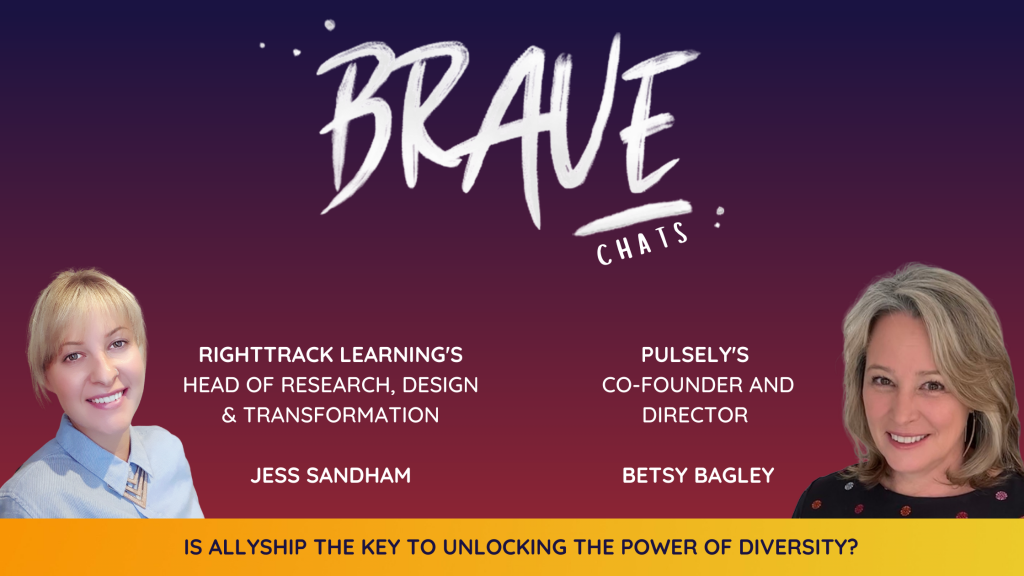Last week, more messages were leaked from a Met Police WhatsApp group, with officers making homophobic slurs, racist remarks and misogynistic comments. Denying that they have a toxic workplace culture, it is apparent that leaders within the organisation do not know how to be an ally, let alone encourage allyship.
This is just one example. We see this and many similar situations happen regularly which result in exclusion, resignations, employees losing confidence, decreased talent and less productivity and engagement.

We speak to Betsy Bagley, Co-founder & DEI Director at Pulsely about how organisations can start to build allyship within the workplace. In her current role, Betsy explores behaviours and attitudes which are aligned with allyship and helps organisations to recognise allies in their own workforce who can help drive cultural change.
With over 30 years experience in data collection and strategy development (the last 20 focusing on D&I), Betsy is an expert in examining patterns in data to reveal opportunities for action.
What is an ally?
Betsy: An ally is someone who isn’t a member but actively supports people from marginalized or underrepresented groups. They show up ‘in the moment’ to shine a light on and disrupt dynamics of inequality.
Can anyone be an ally?
Betsy: Yes anyone and everyone can be an ally, as long as you can recognize your own privilege and use that to support others who do not have that same privilege. If you believe that the workplace should be a level playing field but understand that it isn’t, then you have the ability to become an ally.
What does allyship in the workplace look like?
Betsy: There are many steps towards allyship in the workplace but here are some examples:
- Actively listening to understand other people’s experiences and needs
- Creating a safe space for and amplifying underrepresented voices
- Using inclusive language
- Sharing visible metrics around diversity and inclusion
- Speaking out if you hear or see inappropriate behaviour
- Exploring alternative recruitment approaches
- Visibly championing allyship at top leadership
When may organisations fail with allyship?
Betsy: There can be several barriers within an organisation to really succeeding with allyship. What we often see is, when an organisation isn’t fully vested in championing allyship, the message isn’t clear within the workforce and in turn, there may be learning, but no action.
For example, it may be because of a precedent already set within the workplace culture, but people can be afraid of the uncomfortable situations they may put themselves in when standing up for someone or something. They may see and hear certain behaviour and know that it is inappropriate but are unsure how to go about it – maybe for fear of conflict, fear that their progression in the company will be damaged or they assume that someone else will address the situation.
We need people to have a willingness to engage in these uncomfortable conversations, to address the impact on others, regardless of intent.
When the message isn’t clear, we also see a lot of performative allyship where people may speak out but do it to for their benefit – maybe to increase their social status or protect the brand. Performative allyship is detrimental to the people it’s meant to support and maintains the status quo by appearing to promote change without actually producing change.
How can we be allies in a remote/hybrid working environment?
Betsy: I will be touching on this more during the Brave Chat, however being an ally in a remote/hybrid working environment does require more planning. For example, you and your team are not going to have random chats throughout the day whilst on a tea-break or small talk before a meeting – you need to be intentional and schedule in time to learn about others’ experiences.
If it’s during a video or hybrid meeting, make sure that everyone has the option to be heard. That could be setting a rule where there are no interruptions, instead using the ‘raise a hand’ tool which is often embedded into video-conference platforms. Or just be mindful of whose opinions haven’t been heard – create a space by using language like “I see that Jess has been trying to say something for a while, let’s hear your thoughts”. Always ensure that the meeting lead does a runaround the group at the end of the meeting to see if anyone wants to add anything.
What can organisations do to successfully encourage allyship?
Betsy: The first step is to identify who is an ally within your organisation – whether that be through targeted or open invitations and make allyship visible. Hold training workshops so people learn how to be a better ally or know how to have those courageous conversations. And from that, build programs and tools that enable allies to take action.
Allyship is a journey; a journey towards inclusion. It’s okay to get it wrong sometimes but it’s important to keep educating ourselves and to remember to put that learning into action in order to make a change.
Bespoke training courses
RightTrack Learning is home to a family of learning and development specialists who, through the design and delivery of tailormade training solutions, support organisations just like yours to nurture inclusive workplaces, modern-day leaders and customer service superstars.